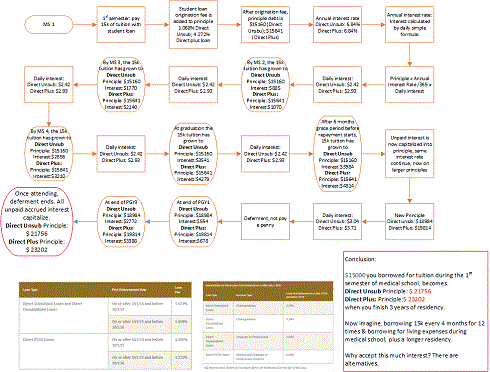Article
The Day I Started with Nothing
Student loans constitute an onerous burden on our generation of doctors. Starting with nothing instead of starting in a huge hole of educational debt is truly a blessing.

On average, the medical school Class of 2015we owed $180,000 in student loans.
I will always remember how dreadful it seemed when I learned that the cost of attendance for my first year of medical school in 2010-2011 was about $90,000. I had never made $90,000 a year prior to starting medical school. (In fact, I still have not made $90,000 a year as a PGY2, six years after I started med school in 2010.) I could not imagine borrowing $90,000. Worse yet, only $8,000 of that was subsidized (interest-free during medical school). The rest came with a 1-4% loan origination fee and 6.8% interest snowballing starting from day one of medical school.
Along with this dread came one of my favorite memories of Mini Wise Money.
I was crying and complaining on the phone to my mom, feeling wronged by the fact that I had to get into so much debt to become a doctor in the US, when the rest of the world pretty much made medical school free, appreciating what aspiring doctors already give up by embracing such an all-consuming and demanding career.
Then, Mini Wise Money, who was 2 years old at the time, tried comforting me.
“Mommy, don’t be scared of monies. I am here,” she said, giving me a hug. “Don’t be scared of monies.”
Due to the high cost of medical school, the day I “started with nothing” was in March 2015, during my internship year, when I was 30 years old.
I tried everything in my power, working seven jobs in college and two jobs in medical school, to “start with nothing” at the age of 30. Meanwhile, my non-med friends already had houses, cars, fat retirement funds, college savings for their kids, and annual family vacations to exotic places.
But I'm grateful to be starting at zero at 30, rather than 40, 50, or 60.
Here today I want to share one major reason why I was able to pay off my student loans within one year of graduating medical school.
Here's my guest post on my financial mentor White Coat Investor's blog, detailing how I minimized and delayed student loan interest.
Hope this helps!
Here is a flow chart that demonstrates how federal student loan interest can snowball starting at Day 1. The chart is provided for numerically inclined people, just so that every step of math is accounted for and the number I'm using has solid backing. Feel free to skip the flow chart if it's dizzying. This flow chart itself warrants two posts’ worth of elaboration (which will be coming in the future).
To summarize the chart:
$15,000 borrowed on Day 1 of med school, plus the loan origination fee, plus daily simple interest* turns into:
--> $17,816 at medical school graduation
--> $21,756 after finishing a three-year residency (with payments deferred during residency)
Now imagine borrowing $15,000 every semester (three times a year, totaling 12 times to finish medical school)!
This is just tuition and fees — not living expenses – and the loan assumption is based on the cheapest (not grad plus) federal student loans.
*In my personal experience, there have been no more subsidized loans as of 2012. But a reader pointed out that he still had subsidized loan in 2013. I’m not sure if there is inter-school variation in federal loan offerings. Either way, during my first two years of medical school, I could borrow a nominal amount — up to $8,000 annually – using subsidized loans. The subsidized loans prevent 100% of the interest accrual during school and the first three years out of school if one selects income-based repayment. After PGY3, subsidized loans will receive a 50% interest subsidy for the negatively amortized portion of the loan like the unsubsidized loans if the borrower is on a REPAYE (Revised Pay As You Earn) plan.

For a larger version of this chart, click here.
- How did you pay for medical school aside from taking out student loans?
- Did you work during medical school? Did working have a positive or negative impact on your academic performance?
- If you are a medical student, what would you do to minimize your student debt burden?
- Do you think the credit card method is too risky? Why or why not?
- Since you have the discipline and intelligence to make it into medical school and/or survive medical school, don't you think you can apply 3% of your brain power to take advantage of credit card offers to help you build net worth?
Please share your insights, questions, experiences below. We are here to help one another :)
This article is for informational purposes only and not intended as a substitute for professional advice. Please consult a professional accountant, financial adviser or lawyer, before making financial decisions.




